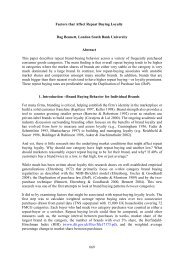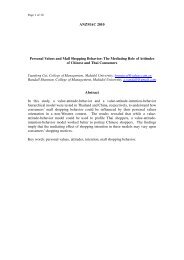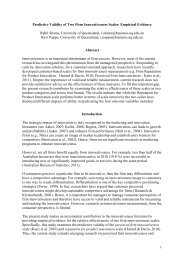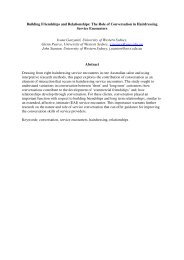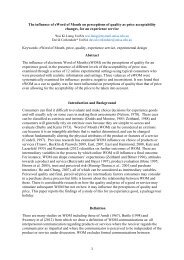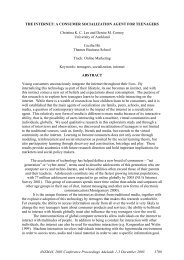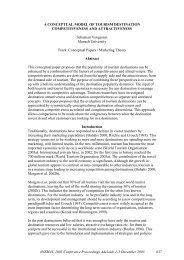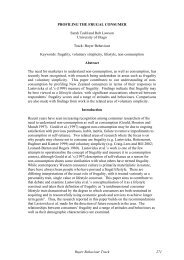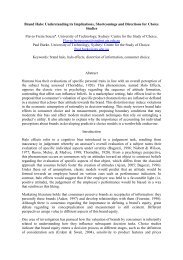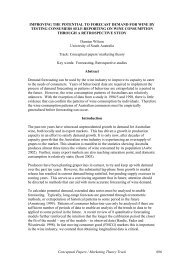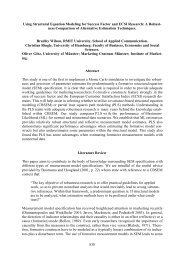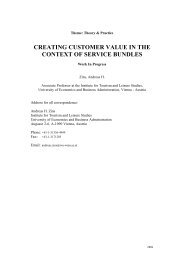amj Australasian Marketing Journal - ANZMAC
amj Australasian Marketing Journal - ANZMAC
amj Australasian Marketing Journal - ANZMAC
Create successful ePaper yourself
Turn your PDF publications into a flip-book with our unique Google optimized e-Paper software.
involvement, materialism, self-monitoring and motives). This<br />
is followed by the presentation of the results for the hypothesised<br />
model. The scales were examined initially via factor<br />
analysis to examine their dimensionality and to establish<br />
consistency and performance compared with usage of the<br />
scales. Overall the scales possessed factor structures and reliabilities<br />
that were consistent with those previously reported. All<br />
factor loadings ranged between .61 and .92 and all reliabilities<br />
were greater than .85, and no items cross-loaded greater than<br />
.2 on other factors, indicating a clean factor structure.<br />
6.1 Fashion Clothing Involvement<br />
The results indicated that the fashion clothing product<br />
involvement measure was uni-dimensional with sound<br />
psychometric properties. Factor loadings for items (shown in<br />
Table 1) ranged from .81 to .92. The reliability estimate<br />
Cronbach Alpha for the scale was .98 indicating high internal<br />
reliability, and a mean score of 2.32 and standard deviation of<br />
1.15.<br />
The purchase decision construct contains items that represents<br />
the degree the consumer is involved in the purchase decision<br />
of fashion clothing. The results indicated that the factor loadings<br />
(shown in Table 1) ranged from .67 to .88. The internal<br />
reliability estimate was .95 indicating high internal reliability,<br />
and a mean score of 3.02 and standard deviation of 1.21.<br />
6.2 Materialism<br />
Analysis of the materialism scale identified three factors and<br />
the results for each factor indicated sound psychometric properties.<br />
The three factors identified (shown in Table 1) are<br />
labelled: acquisition centrality, possession defining success<br />
and the acquisition as the pursuit of happiness and are identical<br />
to those that appear in the literature (see. Richins &<br />
Dawson, 1992). Richins and Dawson (1992) reported<br />
Cronbach alpha values ranging between .71 to .75 for centrality,<br />
.74 to .78 for success and .73 to 83 for happiness and<br />
Browne and Kaldenberg (1997) reported internal consistency<br />
estimates of .86 (sub-scale .73 to .79). The reliability in this<br />
study is higher than those reported in studies by Richins and<br />
Dawson (1992) and Browne and Kaldenberg (1997) with an<br />
alpha of .87, with a mean score of 3.86 and standard deviation<br />
of .98.<br />
6.3 Self-monitoring<br />
Initial factor analysis revealed a two-factor structure comparable<br />
to O Cass (2000) and Lennox and Wolfe (1984), and<br />
were labelled self-monitoring ability and self-monitoring<br />
sensitivity. The results (shown in Table 1) for self-monitoring<br />
ability indicated that the factor structure derived out of the<br />
initial exploratory factor analysis had item loadings ranging<br />
from .71 to .78 and the reliability estimate Cronbach Alpha of<br />
.86. The results for self-monitoring sensitivity indicated that<br />
the factor structure derived out of the initial exploratory factor<br />
analysis had item loadings ranging from .67 to .80, and the<br />
Fashion Clothing Involvement<br />
internal reliability Cronbach Alpha was .85, indicating high<br />
reliability. The overall scale reliability was .86, with a mean<br />
of 4.50 and standard deviation of .66.<br />
6.4 Motives<br />
The factor analysis of the motives revealed 3 factors. Factor 1<br />
was labelled external image oriented (social approval) with a<br />
mean score of 2.72, factor 2 was labelled sensory oriented<br />
(pleasure) with a mean a score of 2.41 and factor 3 was<br />
labelled functional (functional attributes) with a mean score<br />
of 4.25. Reliability analysis indicated the 3 factors all had reliabilities<br />
of above .85.<br />
All constructs were computed into composite (means)<br />
constructs with scores ranging from 1-6, gender was coded a<br />
female = 0 and male = 1, with age being recorded as age in<br />
years, with a mean age of 35.6. The sample contained both<br />
part-time and full-time students and those who study externally<br />
as well as those who study on the university campus and<br />
the age of respondents was also quite broad with age ranges<br />
from 18 to 76. The characteristics of the sample are believed<br />
to be from a fairly good spread of older working individuals<br />
to the more general full-time not working student and thus<br />
represent an adequate sample of respondents. The sample did<br />
not possess the normal characteristics of young, not working<br />
individuals found in many studies using student samples.<br />
7. Model Estimation<br />
Given the nature of the hypothesised relationships between<br />
the constructs it was decided to use the Partial Least Squares<br />
(PLS) estimation procedure to evaluate the theoretical<br />
hypotheses (Lohm eller, 1981; Fornell and Cha, 1994; Wold,<br />
1981). PLS is a general technique for estimating path models<br />
involving latent constructs indirectly observed by multiple<br />
indicators. It was developed by Wold (1981) to avoid the<br />
necessity of large sample sizes and hard assumptions of<br />
normality. For this reason it is often referred to as a form of<br />
soft modeling (Falk and Miller, 1992) and in circumventing<br />
the necessity for the multivariate normal assumption has<br />
immense advantages for non-experimentalists (Kroonenberg,<br />
1990 p. 909). A model in PLS is formally specified by two<br />
sets of linear relations: the outer model in which the relationships<br />
between the latent and the manifest variables are specified;<br />
and the inner model where the hypothesised relationships<br />
between the latent variables are specified and for which<br />
interpretation is as for standardized regression coefficients<br />
(Chin, 1998a,b; Falk and Miller, 1992; Fornell and Cha, 1994;<br />
Kroonenberg, 1990; Lohm eller, 1989; Wold, 1981). Another<br />
major advantage of the PLS is that the outer model formulation<br />
explicitly allows for the specification of both reflective<br />
and formative indicators. Reflective indicators are formed in<br />
the classic test theory factor analytic model and are assumed<br />
to change together or move in the same direction. The formative<br />
indicators, however, are not assumed to measure the same<br />
construct nor are they assumed to be correlated. Rather they<br />
<strong>Australasian</strong> <strong>Marketing</strong> <strong>Journal</strong> 9 (1), 2001 51



